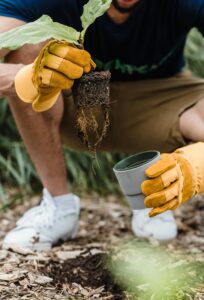Welcome to My Gardens Bloom! As dedicated gardeners, we strive to create vibrant, healthy gardens with flourishing flowers. However, root rot is one common and often devastating issue that can hinder our gardening success. This sneaky disease can quickly turn your thriving flower beds into wilted, discolored messes. This article will delve into what root rot is, its symptoms, its effects on flowers, and most importantly, how to control and prevent it.
What is Root Rot?
Root rot is a plant disease caused primarily by various fungi and oomycetes (water molds) that thrive in wet, poorly drained soils. The most common pathogens responsible for root rot include Phytophthora, Pythium, Rhizoctonia, and Fusarium. These pathogens can persist in the soil and become problematic under conditions that favor their growth, such as excessive moisture and poor soil drainage.
Symptoms of Root Rot
Early detection of this problem is crucial for saving your flowers.
Wilting: Despite adequate watering, infected plants may wilt and appear drought-stressed. This is because the damaged roots cannot absorb water efficiently.
Yellowing Leaves: Leaves may turn yellow and drop prematurely as the plant struggles to transport nutrients.
Stunted Growth: Affected plants often exhibit reduced growth, smaller leaves, and fewer flowers.
Root Discoloration: Healthy roots are typically white and firm. In contrast, roots affected by root rot will be brown, black, or gray and feel mushy or slimy.
Foul Odor: Severely infected roots may emit a foul smell due to decay.
Effects of Root Rot on Flowers
The impact of root rot on flowers can be severe and even fatal if not addressed promptly. Here’s how it affects your plants:
Nutrient Deficiency: Damaged roots cannot absorb nutrients effectively, leading to nutrient deficiencies that manifest as yellowing leaves and poor growth.
Water Stress: With compromised roots, the plant struggles to uptake water, resulting in wilting and dehydration, even in moist soil.
Reduced Blooming: Flowers may produce fewer blooms, and the ones that do appear may be smaller and less vibrant.
Increased Vulnerability: Weakened plants are more susceptible to other diseases and pests, compounding the problem.
Preventing Root Rot
Prevention is the best strategy for managing root rot. Here are some effective preventive measures:
Proper Watering
Water Wisely: Water your plants only when the top inch of soil is dry. Avoid overwatering, which can create waterlogged conditions conducive to root rot.
Deep Watering: Water deeply but infrequently to encourage roots to grow deeper and stronger.
Soil Management
Improve Drainage: Amend heavy soils with organic matter like compost or well-rotted manure to enhance drainage. Raised beds can also help prevent waterlogging.
Soil Testing: Check your soil’s pH and nutrient levels. Grape hyacinths, for instance, prefer slightly acidic to neutral soil (pH 6.0-7.0).
Plant Selection and Spacing
Choose Resilient Plants: Some plants are more tolerant of wet conditions. Select varieties known for their resistance to root rot.
Proper Spacing: Ensure adequate spacing between plants to promote good air circulation, reducing the risk of fungal diseases.
Sterile Practices
Clean Tools: Sterilize gardening tools and containers before use to prevent the spread of pathogens.
Healthy Transplants: Inspect new plants for signs of disease before introducing them to your garden.
Controlling Root Rot
If you detect root rot early, there are steps you can take to save your plants:
Remove Affected Plants
Isolate the Problem: Remove and destroy severely affected plants to prevent the spread of pathogens.
Examine Roots: If you catch root rot early, carefully dig up the affected plant and inspect the roots. Trim away any diseased portions.
Improve Soil Conditions
Amend the Soil: Enhance soil drainage by adding organic matter. For container plants, ensure pots have adequate drainage holes.
Reduce Watering: Adjust your watering schedule to avoid waterlogging and allow the soil to dry out between waterings.
Fungicide Treatment
Apply Fungicide: In some cases, applying a fungicide can help control this disease. Choose a product labeled for root rot and follow the instructions carefully.
Natural Remedies: Some gardeners use natural fungicides, such as neem oil or hydrogen peroxide solutions, to combat root rot.
Repotting (for Container Plants)
Fresh Soil: For potted plants, remove the plant from the pot, trim away affected roots, and repot in fresh, sterile soil. Ensure the new container has good drainage.

Seasonal Care Tips for Preventing Root Rot
Fall
Plant bulbs and perennials in well-drained soil, following proper spacing guidelines.
Apply mulch to protect soil from extreme cold and moisture fluctuations.
Winter
Check soil moisture levels regularly, as plants need less water during dormancy.
Spring
Resume regular watering as new growth appears, but avoid waterlogging.
Apply a balanced fertilizer to support new growth and blooming.
Summer
Keep an eye out for signs of root rot, especially after heavy rains.
Water deeply but less frequently during hot weather to encourage deep root growth.
Root rot is a formidable foe in the garden, but with vigilance and proper care, you can protect your flowers from this destructive disease. By understanding the symptoms, effects, and preventive measures, you can maintain a healthy, thriving garden. Remember, the key to preventing root rot lies in well-drained soil, proper watering practices, and choosing the right plants for your garden conditions.
Thank you for visiting My Gardens Bloom! We hope this guide helps you keep your garden vibrant and beautiful. If you have any questions or tips to share about managing root rot, please leave a comment below. Happy gardening!


